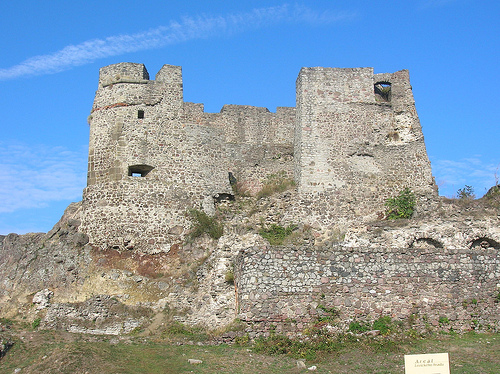

Location: 60 km (24 mi) South of Nitra, Nitra Region
Constructed: 14th century
Levice Castle is a medieval fortress situated in Levice, 60 km (24 mi) South of Nitra, Nitra Region in Slovakia. Levice Castle was erected in 13th century on a rock outcropping in the Hron River valley. It guarded the trade road that leads to medieval mining cities. Military citadel first attacked by the troops of the Ottoman Turkish empire in 1544. They burned down the houses of the civilians that lived around the castle, but the walls proved to be too difficult to storm. The citadel was stormed and taken by the Turkish armies in 1663, but a year later in 1664 they were defeated at the Battle of Levice. Badly damaged military fortifications were reconstructed under supervision of General Louis Raduit de Souches who lead his Austrian Imperial Army to victory and capturing the Levice hrad. The Levice Castle was finally destroyed during military engaged between Imperial army and Rákóczi’s rebellious troops. It was abandoned in ruins since then.
The castle was built in the second half of the 13th century with the
aim of preventing southern access to the Central Slovak mining towns. A
rocky ridge surrounded by swampy territory was chosen as the place of
its construction. At its highest point, they built a Gothic castle,
which became part of the estate of Matúš Čák Trenčiansky, later it
became a royal castle.
In 1388 it became the property of the
Levick family. In 1434 the castle was engulfed in fire; it was
immediately rebuilt. In 1529 it belonged to the crown and belonged to
the Tek county. After the death of the mayor Gabriel Levický, the castle
came into the possession of the well-known robber nobleman Melchior
Balaša. His actions resulted in the siege of the castle by the imperial
army, which resulted in the capitulation of the castle garrison and the
execution of some of its members directly under the castle walls. After
the extinction of the Levick family in 1553, the castle again belonged
to the king, who incorporated the castle into the system of anti-Turkish
fortresses. In the following periods, several owners changed in the
castle - Dobóovci (František became the county governor of Tekov in
1574), Koloničovci, Čákyovci and Esterháziovci.
In the middle of
the 16th century, the castle was repaired and in 1571 a Renaissance
manor house with corner bastions was added to the lower courtyard. Even
in the first half of the 17th century, the castle fortifications were
improved (after 1635, the outer fortifications were connected to the
city walls, from which the castle was separated by a moat). According to
parliamentary resolutions, the subjects of the northern capitals (Orava
and Liptov) also took part in the fortification works.
Turkish
military actions have affected the history of the castle. The Turks
first appeared under its walls in 1544; during the next siege in 1663
the castle was conquered. A year later, however, they were pushed out of
Levice in the famous battle of Levice and once again fortified the
castle thoroughly under the supervision of the then famous military
commander L. de Souches.
After the town fire in 1696, the badly
damaged castle began to be demolished. In 1699, the castle was abandoned
by a military garrison, which lost the castle's defensive character.
Vojská Františka II. However, Rákoci was still held in the years 1702 -
1709, but before his departure they completed its liquidation. Part of
the buildings (bastion and manor house) were preserved and repaired
after 1710.
The masonry of the upper castle with a Gothic palace, the eastern bastion (used as a tea house), the south-western bastion (serving as an amphitheater) have been preserved from the castle. The area includes the Dobó Renaissance manor house from the 16th century and the captain's house with a western bastion, the seat of the Tekovsky Museum, which is the administrator of the castle.